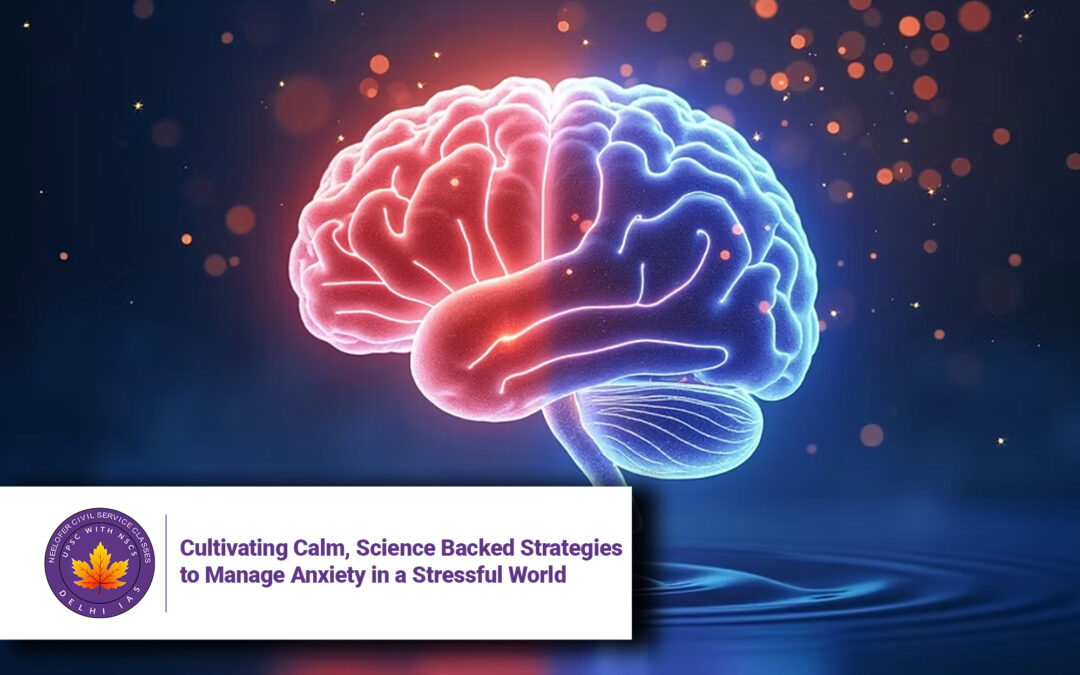Cultivating Calm, Science Backed Strategies to Manage Anxiety in a Stressful World
Introduction
In today’s hyper-connected, fast-paced society, anxiety has emerged as a silent epidemic. The World Health Organization (WHO) reports that anxiety disorders affect over 284 million people globally, making it one of the most prevalent mental health conditions. While stress is a natural human response, chronic anxiety can be debilitating, affecting emotional stability, physical health, and overall quality of life.
This article explores:
-
What anxiety really is (and when it becomes a disorder)
-
The mind-body connection in anxiety
-
Proven strategies to reduce anxiety naturally
-
When to seek professional help
-
The role of lifestyle in mental wellness
With mental health awareness growing, understanding anxiety management is more crucial than ever.
Understanding Anxiety: Normal Stress vs. Anxiety Disorders
1. Anxiety as a Survival Mechanism
Anxiety is the body’s natural response to perceived threats—a “fight or flight” reaction that kept our ancestors alive. In modern times, this response can be triggered by:
-
Work deadlines
-
Financial stress
-
Social pressures
-
Health concerns
2. When Anxiety Becomes a Disorder
Anxiety becomes problematic when it is:
-
Persistent (lasting months)
-
Disproportionate (excessive worry over minor issues)
-
Debilitating (interfering with daily life)
Common Anxiety Disorders
| Disorder | Key Symptoms |
|---|---|
| Generalized Anxiety Disorder (GAD) | Chronic worry, restlessness, fatigue |
| Panic Disorder | Sudden panic attacks, chest pain, dizziness |
| Social Anxiety Disorder | Fear of judgment, avoidance of social situations |
| Phobias | Irrational fear of specific objects/situations |
Recognizing these signs is the first step toward managing anxiety effectively.
The Mind-Body Connection: How Anxiety Affects Physical Health
Chronic anxiety doesn’t just impact mental well-being—it rewires the brain and strains the body:
1. Brain Changes
-
Overactive amygdala (fear center)
-
Reduced prefrontal cortex activity (impairs rational thinking)
2. Physical Symptoms
-
Rapid heartbeat, sweating, trembling
-
Digestive issues (IBS, nausea)
-
Weakened immune system
-
Muscle tension and chronic pain
Key Insight: Managing anxiety isn’t just about calming the mind—it’s about healing the body too.
Science-Backed Strategies to Reduce Anxiety
1. Master Mindful Breathing
Why it works: Deep breathing activates the parasympathetic nervous system, countering the stress response.
Effective Techniques:
-
4-7-8 Breathing: Inhale (4 sec), hold (7 sec), exhale (8 sec)
-
Box Breathing: Inhale (4 sec), hold (4 sec), exhale (4 sec), hold (4 sec)
Tip: Practice for 5 minutes daily to lower baseline anxiety.
2. Exercise: Nature’s Anti-Anxiety Pill
How it helps:
-
Releases endorphins (natural mood boosters)
-
Reduces cortisol (stress hormone)
-
Improves sleep quality
Best exercises:
-
Cardio (running, swimming, cycling)
-
Yoga & Tai Chi (combine movement + mindfulness)
3. Prioritize Sleep Hygiene
Sleep deprivation worsens anxiety. Improve sleep by:
Keeping a consistent sleep schedule
Avoiding screens 1 hour before bed
Creating a dark, cool sleeping environment
4. Nutrition: Eat to Beat Anxiety
Foods that help:
-
Omega-3s (salmon, walnuts) – Reduce inflammation
-
Probiotics (yogurt, kimchi) – Support gut-brain axis
-
Magnesium (spinach, almonds) – Calms the nervous system
Avoid:
Excess caffeine (triggers adrenaline)
Sugar & processed foods (cause energy crashes)
5. Cognitive Behavioral Therapy (CBT) Techniques
Challenge negative thoughts with:
-
Evidence-checking: “Is this worry based on facts?”
-
Reframing: “What’s a more balanced perspective?”
-
Gratitude journaling – Shifts focus to positivity
6. Limit Anxiety Triggers
-
Reduce news/social media consumption
-
Set boundaries with toxic people
-
Practice digital detoxes
7. Social Connection: The Ultimate Anxiety Buffer
Loneliness worsens anxiety. Combat it by:
-
Spending time with loved ones
-
Joining support groups
-
Volunteering (boosts serotonin)
When to Seek Professional Help
While self-help strategies work for mild anxiety, professional intervention is needed if:
Anxiety disrupts daily functioning
Panic attacks occur frequently
Physical symptoms (chest pain, insomnia) persist
Treatment Options:
-
Therapy (CBT, exposure therapy)
-
Medication (SSRIs, benzodiazepines – short-term)
-
Mindfulness-Based Stress Reduction (MBSR)
Remember: Seeking help is a sign of strength, not weakness.
Conclusion: Anxiety Management Is a Lifelong Practice
Anxiety may never fully disappear, but with consistent, mindful habits, it can be managed effectively. By integrating:
✔ Breathing exercises
✔ Regular movement
✔ Healthy eating
✔ Sleep hygiene
✔ Social connection
You can rewire your brain for calm and reclaim control over your mental well-being.
5 Q&A on Anxiety Management
1. What’s the difference between normal anxiety and an anxiety disorder?
Answer: Normal anxiety is temporary (e.g., before a speech). An anxiety disorder is chronic, excessive, and disrupts daily life.
2. Can exercise really reduce anxiety?
Answer: Yes! Exercise releases endorphins, lowers cortisol, and improves sleep—all of which reduce anxiety.
3. How does caffeine affect anxiety?
Answer: Caffeine increases adrenaline, mimicking panic symptoms. Cutting back can significantly lower anxiety.
4. When should I see a therapist for anxiety?
Answer: If anxiety lasts months, causes panic attacks, or interferes with work/relationships, seek professional help.
5. What’s the quickest way to calm an anxiety attack?
Answer: 4-7-8 breathing: Inhale (4 sec), hold (7 sec), exhale (8 sec). Repeat until calm.







